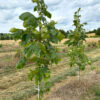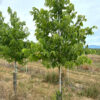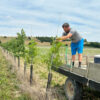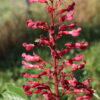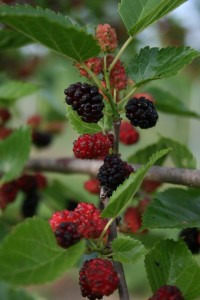
White House Natives June 2015
“Spring planting at the nursery – not just digging holes. More about precision and planning.”
Spring is a busy season at White House Natives. Like most field growing nursery operations, there are several critical tasks that must be done just at the right season. We completed harvesting nearly 800 trees and then immediately needed to allocate our resources to planting 2,200 liners, which will be harvestable in 3-5 years. While the actual planting of our liners may only take a few days, the process leading up to it takes several months of careful planning and preparation in the field, all while working in harmony with Mother Nature and frequently challenging weather patterns.
The planting process starts the previous summer, with careful selection of liners, typically three gallon size containers, from select growers with whom we have partnerships to provide consistent and uniform native plants. During the winter we prepare by plotting out the new fields for proper spacing. We are excited to see the benefits of our new collaboration with Tellus Agronomics, a leading expert in soil and crop management. We closely monitor the soil moisture level, which determines when we begin mechanical soil preparation. First, sub soiling breaks up any hardpan created from former agricultural practices and then further tilling ensures superior soil conditions for planting and long term growth. In addition, during the winter we invest in our irrigation infrastructure so that when we start to plant, liners get watered the same day, reducing any transplant stress and getting them immediately off to a good start.
With spring comes the arrival of several truckloads of liners that need to be acclimated until the soil is ready for planting. Each row is carefully laid out in straight lines and liners are installed by hand onsix foot intervals which provides more than enough space for full head development. During the planting process, we pay close attention to several key details: eliminate any circling roots, ensure even root distribution, installation at the proper planting depth at the root flare, firm the soil to eliminate any air pockets and accommodate for settling, and -guarantee straightness. Any corrections needed for proper establishment and long term success are made by Eric Sours, nursery manager.
Once the liners are planted, we take a deep breath and hope for rain. Even with drip irrigation there is no substitute for a good soaking rain to settle the soil. Immediately, we begin to follow up with additional steps to make sure each plant gets the best possible start and opportunity to become a superior commercially viable tree. Each liner gets either a bamboo or fiberglass stake and is secured with expandable nursery tape to help promote a straight trunk and uniform crop. All of our new trees get watered daily with a drip emitter at each sapling, which places the moisture right at the new root zone and helps conserve water.
We are very proud of the enormous effort that we undertake to make sure our liners get the best possible start. Our crew from Shen-Paco Industries, Inc. is in their second year and we could not get all of this done without their help (See December news link) for our past collaboration with the organization). Regular maintenance will commence with pruning, tying, mowing, and weed/insect control, which we will discuss in our upcoming July newsletter.
If there are trees you would like to see us grow, please let us know now so we can source the liners this summer to have them ready for planting in 2016. I would like to extend you a personal invitation to schedule a tour this summer with White House Natives.
Matt Deivert
President/Principal
White House Natives, LLC
FAX: 703.327.5091
Mobile: 571.220.1483
Email: info@whitehousenatives.com


